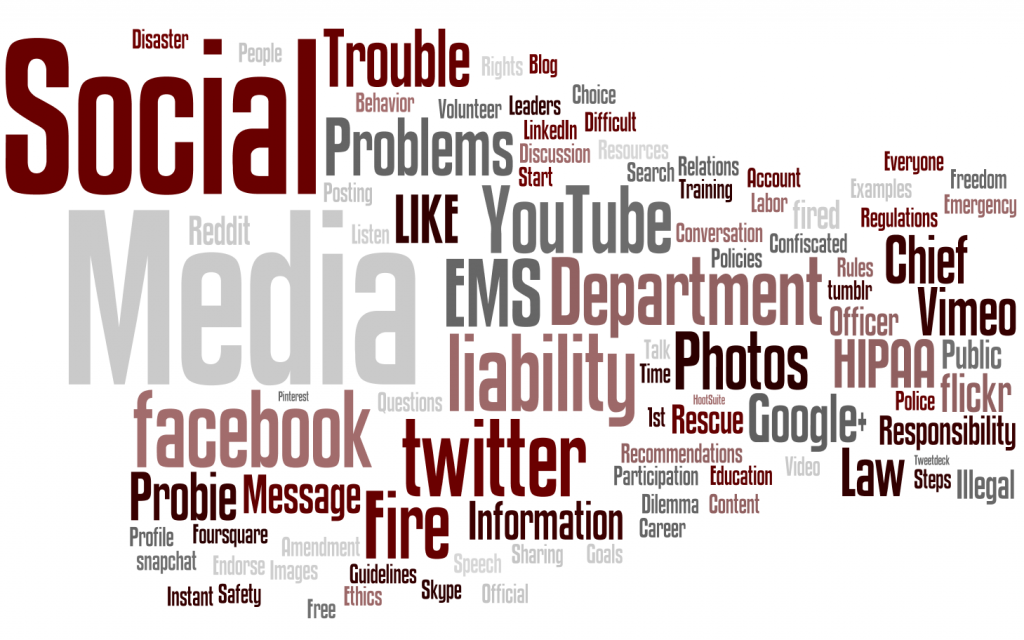The biggest problem…
With today’s social media use policies are the gigantic swaths of “gray area” that shroud some issues. Not only do statutes and regulations vary tremendously from state to state and workplace to workplace, but as social media case law develops it can be difficult to determine how key phrases such as “free speech”, “privacy protection”, and “on-the-job” apply to any given situation. In order to deal with this confusion many agencies attempt to enact blanket policies that, for instance, forbid staff from ever saying anything negative about the agency. Again and again policies such as these have been struck down in the courts for being too broad and overreaching. So what’s a policy developer to do?
Social Media in Fire and EMS What’s the answer? 4
- The first step is to find a trusted expert in human resources/legal issues that understands both social media and emergency services.
- The second step is to better define the questions. there are no policies that can “make sure you don’t get in trouble.” Figure out what situations you want to address and ask your expert (or several experts) how best to deal with this within your state and within your workplace.
- The third step is to cover the basics. While some of the most difficult “gray area” questions take specific expertise to answer, there are plenty of issues that are “black and white” which can be addressed right now. In fact, the top 20 are right below.
- The fourth step is education. It isn’t anywhere near enough simply to have a policy written down somewhere to “have you covered”. The distinctions of who can use social media, how, when, and for what purposes can be subtle. No matter how clearly you address them in your written policies, if you don’t talk about it to your staff face-to-face then you’re effectively telling everyone that the policies are in place to be punitive, rather than to prevent something from becoming an issue.
What can I do right now? 20+10
Whether you’re building them from the ground up or looking to review and revise them, make sure that your social media policies and education programs address these 20 items as well as the 10 guidelines for responsible social media use to share with your staff.
- Focus on guidance rather than discipline. Policies should be written in plain language highlighting the take-home point of each recommendation. If the policy must include complicated or technical language, highlight a plain language take-home point at the end of each recommendation.
- Identify the scope of the policies, usually including definition of social media, acquiring information and images, and the inclusion of members of the agency.
- Identify standards of ethics and professionalism that guide behavior both real-world and online.
- Broad policies generally prohibiting the portrayal of an agency in any negative manner are unlikely to withstand legal scrutiny.
- Identify official social media channels and the methods for members to submit items/posts/content to these channels.
- Identify agency titles, logos, and other items that identify a person as an official spokesperson, whether intentionally or not and educate staff as to the proper use and public perception (authorized spokesperson) of these.
- Identify the special role that an emergency responder has in the community and the need to respect the privacy of members of the community above and beyond HIPAA other regulations.
- Identify the limits that may be placed upon the free speech to which an individual may be implicitly agreeing when accepting a position as an emergency responder.
- Identify that the acquisition of information or images or the use of social media should never interfere directly with the responsibilities of an emergency responder or indirectly with the operation of the agency including undermining the reputation or cohesion of the agency.
- Identify agency ownership of information and images as it may pertain to use of agency equipment or acquisition of the information and images while acting as an agent of the agency.
- Identify that the use of any personal electronic equipment to acquire or transmit images or information related to agency operations may cause it to be considered evidence and may be subject to search and seizure.
- Identify the responsibility that a member of the agency takes on when using social media to recommend, “Like”, or otherwise endorse an item on social media.
- Identify that privacy effectively does not exist in the world of social media.
- Identify that the acquisition of information and digital images may result in these being shared publicly, even if it is not the intention of the emergency responder.
- Identify the personal responsibility that an emergency responder takes when acquiring information or images or posting anything to social media, even when these are re-distributed by someone else.
- Identify the rights of the public to record and share activities of emergency responders occurring within public view. Include recommendations for dealing with these situations.
- Identify other agency policies as well as local and state policies, regulations, and laws that govern the acquisition of images or use of social media.
- Identify the responsibility of each responder to report violations to the compliance officer or other officer.
- Utilize the following guidelines when posting something to social media.
- Use common sense and be respectful. Consider how your posting could reflect negatively on you and your agency if it was posted on the front lawn outside where you live.
- There is no privacy on the Internet. Remember, you do not control what happens to a message once it is posted.
- Pause before posting. Keep your cool. Don’t feed the trolls.
- If you feel strongly about a particular topic, consider taking real-world action to affect the real-world change that you desire.
- Consider if there is something in your post or social media profile that identifies you as an official spokesperson for your agency, whether intentional or not. Identifying a post as your personal position and not associated with an agency is a good start, but is meaningless when, for example, your profile picture shows you wearing the agency logo.
- Consider submitting your post through official agency channels. If you’re unsure about something, ask. Policies apply to all members of the departments
- Respect the privacy of patients, victims, and bystanders as well as responders, officers, and the agency itself.
- Don’t let the acquisition or posting of social media content interfere with the job that you’re here to do.
- Respect the law, including laws governing defamation, discrimination, harassment, and copyright.
- Just because someone else in another agency is doing it neither makes it okay, nor the right thing to be doing.
- Educate members of the agency on the general use of social media as well as these agency specific policies and relevant state and local laws.
While this might not cover every conceivable aspect of social media that your department will need to address, it should give you a good foundation and help you ask better questions of the experts.
 Rescue Digest Helping You Help Others
Rescue Digest Helping You Help Others
